Ælfric’s Labor Found
I am back! Returned from Shake-speare wars abroad to cultivate my own country garden once again at The Festival Robe. There’s been exciting developments of late, so my home base seems like the best place to toss around some ideas.
Roger Stritmatter has presented some fascinating and potentially very important research on his Shake-speare’s Bible blog here. A copy of Lambarde’s Archaionomia (1568) at the Folger Library has long been known to contain a possible signature of Wm Shakspere on it. Roger drew attention to the fact that while this signature has drawn attention of Stratfordian scholars before, they seem to have ignored the annotations within the volume. The annotations are interesting in part because they are bi-lingual, in both Latin and Anglo-Saxon (Old English.) Here’s one of the annotations.
click to enlarge
The annotation translates from Anglo-Saxon as “Libra in Latin is pound in English. Five pence makes a shilling and thirty pence a mancus.”
A mancus is an obsolete monetary denomination from the period.
Both annotations reference measures or money. With some searching of Shakespeare, I turned up the following in Love’s Labour’s Lost, Act III sc 1.
“My sweet ounce of man’s flesh! my incony Jew!
Exit MOTH
Now will I look to his remuneration. Remuneration!
O, that’s the Latin word for three farthings: three
farthings–remuneration.–‘What’s the price of this
inkle?’–‘One penny.’–‘No, I’ll give you a
remuneration:’ why, it carries it. Remuneration!
why, it is a fairer name than French crown. I will
never buy and sell out of this word.”
The parallels are clear – Libra in Latin is pound in English and Remuneration, O that’s the Latin word for three farthings. Love’s Labor’s Lost seems to reference and parody the annotation. In the annotation, the Latin word Libra is not a unit of Roman money, though it’s translation into English is a unit of currency. That fact is mirrored in the Loves’ Labour’s Lost echo.
But what is the source of this annotation from the Archaionomia?
An Oxfordian critic claimed the annotation a forgery, as schilling was not worth five pence until decimalization in 1971. A look at the OED definition clarified that discrepancy.
click to enlarge
The OED states that prior to the Norman Conquest the shilling was indeed worth five pence. But the entry showed something much more interesting than that fact. The second citation above is from an 11th century text called Ælfric’s Grammar and Glossary, and it exactly matches the notation in Lambarde!
Here’s the text in question from Ælfric’s Grammar and Glossary.
click to enlarge
The entire annotation from Lambarde is from Ælfric’s Grammar and Glossary! There are a few slight differences. There were 15 manuscripts or fragments of Ælfric’s Grammar that survive. The footnotes here detail the differences. The annotation denotes XXX for ‘thirty’ instead of prittig. The annotation also spells shilling scillingc. The footnotes show that manuscript “U” bears those same idiosyncrasies. Where is manuscript “U?”
click to enlarge
It’s in the University library at Cambridge (as distinct from the copy in the Parker collection in Cambridge.)
Who Was Ælfric and what was the importance of his Grammar & Glossary? And why is it annotated in Lamberde’s Archaionomia?
Ælfric was a 10th century monk whose writings formed the basis of much Tudor scholarship into the Anglo-Saxon language. At the center of that scholarship was Laurance Nowell. Nowell transcribed a copy of the Grammar & Glossary for his own use that was also handed on to Lamberde when Nowell left for the continent in 1567. The Grammar & Glossary was a primary tool for learning and translating Old English (Anglo-Saxon.) Oxfordians will quickly recognize Laurence Nowell as one of Edward de Vere’s tutors at Cecil house.
Much of the rest of this post will reference Rebecca Brackmann’s The Elizabethan Invention of Anglo Saxon England Laurence Nowell, William Lambarde, and the study of Old English. I think this is an important book for all serious Oxfordians to read. A number of excerpts are provided here. For starters, from page 43.
click to enlarge
Menzer’s article on Ælfric is available on jstor. Here’s her conclusion.
click to enlarge
Ælfric used his Grammar to teach the vernacular in the 10th century. This is a revolutionary idea, as previously it’s believed that only Latin grammar was taught until much later. It also explains how Tudor scholars viewed Ælfric’s Grammar as useful for translating Old English texts. That was the Nowell method. Whoever annotated Lamberde’s Archaionomia appears to follow Nowell’s method, i.e. have a copy of Ælfric’s Grammar nearby. But the Grammar wasn’t in print. The annotator had to have access to either a medieval manuscript, or a transcript, such as the one Nowell copied from a now-lost Medieval manuscript. Nowell’s transcript is in the Westminster Abbey library – MS 30. It would certainly be interesting to see if it has the same idiosyncrasies as the annotation in the Archaionomia!
Nowell was involved in the compilation of the materials in the Archaionomia. Lamberde gives him credit in the preface. Here’s the English translation from the Latin preface of the Archaionomia given in Brackmann, pg 197.
“Last year, Laurence Nowell the most diligent researcher of antiquity, who is bound to me through much sweet intimacy and who made me whoever I am in this field, presented to me the ancient laws of the English, written in the most ancient language of the Saxons and in their script and (since he was then about to travel overseas), he vigorously urged me to turn them into Latin and publish them.”
Brackmann gives us more information on Nowell’s interest in Ælfric on page 21.
click to enlarge
Brackmann has much to say of interest to Oxfordians – page 49.
click to enlarge
She expresses similar thoughts in another paper on Alfred’s Laws available online.
Laurence Nowell’s Edition and Translation of the Laws of Alfred in London, British Library Henry Davis 59
Rebecca Brackmann
“So why, in the face of all these reasons, did Nowell write his translation of the laws in English? Potential answers to this question lie outside the evidence of the manuscript itself, in Nowell’s intellectual cohort and professional associations. Nowell, during most of the period that he was working on his Anglo-Saxon studies, lived in William Cecil’s house, first as a tutor to Cecil’s ward, the young Earl of Oxford, then as a sort of secretary-cum-consultant for Cecil’s own antiquarian studies. During much of that time, one of the most famous English translators of the mid-sixteenth century, Arthur Golding, also lived with Cecil. Golding was the Earl of Oxford’s guardian and uncle, and Nowell must have been closely associated with Golding in his capacity as Oxford’s tutor. They were roughly the same age, lived together in Cecil’s house, and were both engaged in the study and translation of ancient texts—Golding working on classical Latin, Nowell working on Old English. It would not be surprising if some kind of cross-pollination took place under those circumstances. Although there is not space here for a detailed examination of Golding’s translations, we can look at some of the features that might provide context for Nowell’s translation of the laws of Alfred and help us to understand Nowell’s project, not as an isolated endeavor, but an exercise that took place within a growing interest in English translation.”
Further information on the literary and language salon at Cecil house in the 1560s is provided on pg 60 of Brackmann.
click to enlarge
And still more, from page 63 of Brackmann.
click to enlarge
There’s a lot to digest in this post. The bottom line is the book in the Folger library with the name Wm Shakspeare written on the top was researched and produced in part by de Vere’s tutor, Laurence Nowell within a language salon at Cecil house in the 1560s where Edward de Vere also lived.
I’ll explore how the quote from Ælfric came into the Archaionomia as well as it’s nod in Love’s Labour’s Lost and the implications for all this information in my next post. Meanwhile, there is much here for all to digest – or perhaps more precisely, translate!


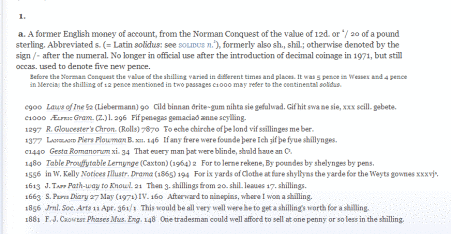
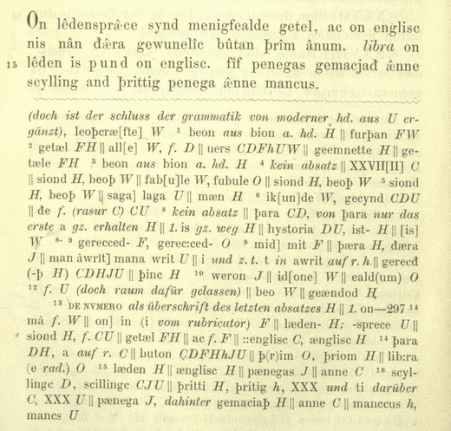
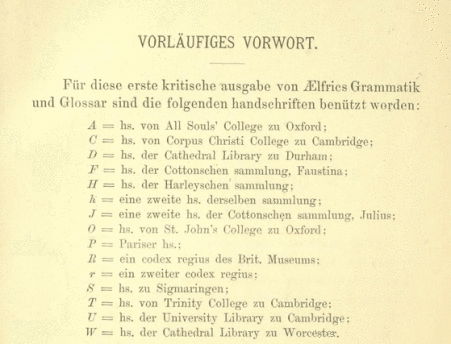
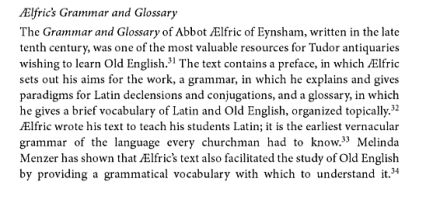
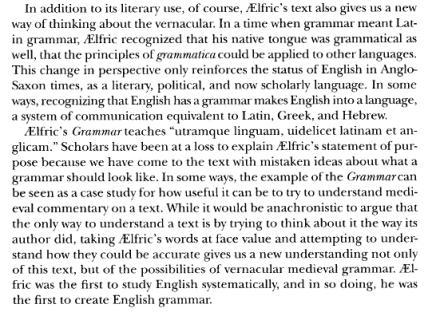
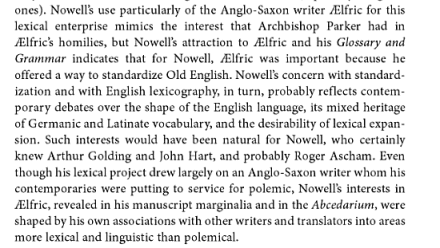
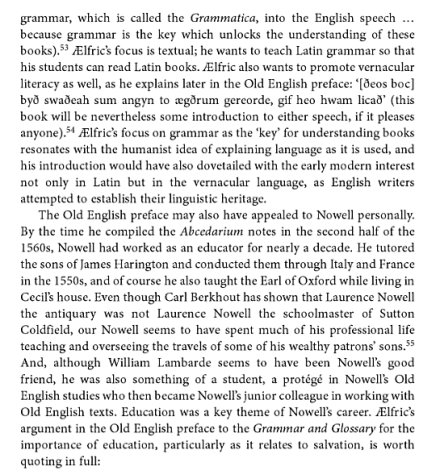
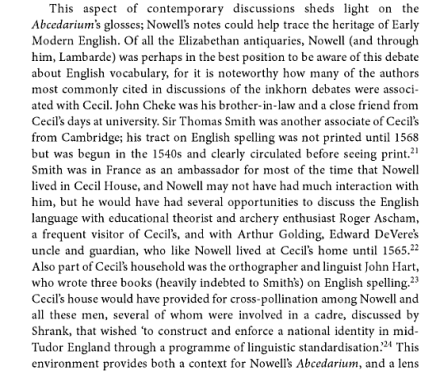
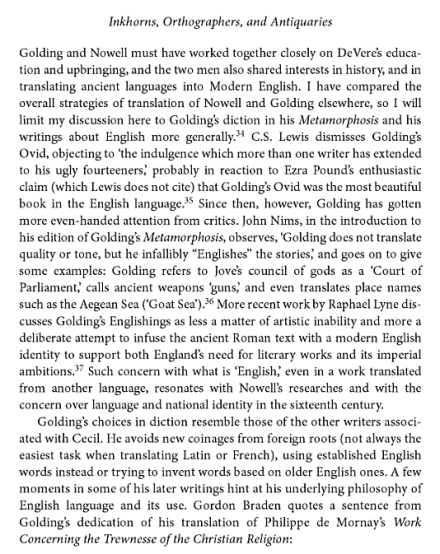

1 comment
Good stuff! If you have time, check out my page on Nowell and Lambarde from 2007. http://politicworm.com/oxford-shakespeare/the-big-six-candidates/oxford-and-the-english-literary-renaissance/shakespeare-smith-and-cecil-2/laurence-nowell-and-william-lambarde/
Leave a Comment